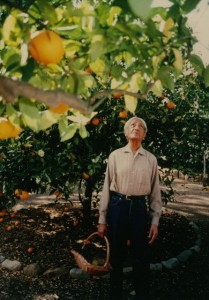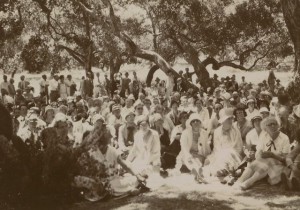By Ellen Sklarz
“He traveled the world for sixty-five years and spoke to more people than anyone else in modern history. His name was J. Krishnmaurti.”
-From the 1989 documentary film, With a Silent Mind
Jiddu Krishnamurti was born on May 12, 1895, in south India to middle-class Brahmin parents. For more than sixty-five years, until his death at age ninety, he traveled the world speaking to large audiences, not as an authority but as a lover of truth. He engaged in dialogues with religious leaders, scientists, teachers, authors, psychologists, students, celebrities and other interested people.
 Many years ago, Krishnamurti told a friend, “If I had nowhere to go in the world, I would come to Ojai. I would sit under an orange tree; it would shade me from the sun, and I could live on the fruit.” He first came to the Ojai Valley in 1922 with his brother Nityananda, who had tuberculosis and needed to live in a warm, dry climate.
Many years ago, Krishnamurti told a friend, “If I had nowhere to go in the world, I would come to Ojai. I would sit under an orange tree; it would shade me from the sun, and I could live on the fruit.” He first came to the Ojai Valley in 1922 with his brother Nityananda, who had tuberculosis and needed to live in a warm, dry climate.
The Ojai Valley of the 1920s, 30s and 40s was quite different than it is today. The population was smaller, the roads were unpaved, no doors were locked, and there was no traffic. World War II hardly touched the valley, and its stillness and unspoiled splendor soothed most of the people who came here. Krishnamurti also loved the untouched beauty, the tranquility, and the climate of the valley. Ojai offered him relief from crowds of people who flocked to hear him speak in Europe, India, Australia and throughout the United States.
Krishnamurti’s life in the valley was quiet. Wearing a large Mexican hat to shade him while walking, he mingled and sang songs with the orange pickers working in the East End groves. He walked all through the hills and to the top of the Topa Topa ridge and Chief Peak. He went to the Ojai Theater, if a Disney movie, animal film, or American musical classic such as “Oklahoma,” ” Brigadoon,” or “Annie Get Your Gun” was playing.
Some have said that Krishnamurti indirectly established the intellectual and social climate of the Ojai Valley. From his earliest days here, he attracted people from all over the world who traveled here to interview him and attend his yearly talks in the Oak Grove in Meiners Oaks. Among those were Aldous Huxley and Dr. David Bohm, Jackson Pollack, Christopher Isherwood, and Ann Morrow Lindbergh. Hollywood stars such as Charlie Chaplin, Elsa Lanchester, Greta Garbo, and Charles Laughton also came to the valley to hear him, as his reputation grew worldwide.
Krishnamurti met with everyone – famous or unknown, intellectual or not – listening and asking questions about the deeper issues of life that are relevant to all people. Those thought-provoking discussions and talks were initially recorded as verbatim reports, and in later years on audio and video tapes. But most people have come to know of these teachings through books.
 In 1969, Krishnamurti and a group of trustees formed the Krishnamurti Foundation of America (KFA). Today, the KFA is part of a group of Krishnamurti foundations in England, Latin America, Canada, and India, with committees of the foundations located throughout the world. These organizations had, and still have, the unambiguous purpose of preserving, protecting, and disseminating Krishnamurti’s teachings. He asked that this new foundation and the existing foundations do nothing to interpret or explain the teachings. The dialogues hosted by all the foundations offer a process of inquiry into issues of life and living.
In 1969, Krishnamurti and a group of trustees formed the Krishnamurti Foundation of America (KFA). Today, the KFA is part of a group of Krishnamurti foundations in England, Latin America, Canada, and India, with committees of the foundations located throughout the world. These organizations had, and still have, the unambiguous purpose of preserving, protecting, and disseminating Krishnamurti’s teachings. He asked that this new foundation and the existing foundations do nothing to interpret or explain the teachings. The dialogues hosted by all the foundations offer a process of inquiry into issues of life and living.
Today, the KFA is still thriving, with many people coming to stay at the Krishnamurti Retreat, located in the East End. The turn-of-the-century California ranch house had been Krishnamurti’s home in the Ojai Valley for many years, and has recently been refurbished for visiting guests who come to explore the depth of the teachings or to simply be alone and quiet. Situated among eucalyptus, cypress and cedar trees, the house is next door to the Krishnamurti Archives building and the Krishnamurti Library.
In 1973, Krishnamurti articulated plans to open a school in Ojai similar to those he founded in India and England. He asked R.E. Mark Lee, the former principal of the Rishi Valley Junior School in south India, to come here with his wife, Asha, and their daughters. Lee would be the founding director of the new school and develop it on the 175 acres of virgin land on Lomita Avenue in Meiners Oaks.
In 1975, the Oak Grove School opened with three students and two teachers in Arya Vihara, the rambling ranch house on McAndrew Drive that had been Krishnamurti’s home from the 1920s. The school moved to the Meiners Oaks property in 1977. A warm family atmosphere prevailed, with everyone helping with the maintenance of the house and property. Asha Lee organized the kitchen and garden, and looked after the many guests who came from all over the world. Later, Alan Hooker of the Ranch House joined her. Michael Krohnen was trained as the school and foundation chef, later writing the renowned Kitchen Chronicles: 1001 Lunches with J. Krishnamurti.
Krishnamurti talked with the staff about the ancient gurukul educational concept in India in which students came to the home of a teacher to learn and participate in all activities of living. Currently present at Oak Grove School is this holistic learning concept, balancing high academic achievement with a nurturing atmosphere that helps children mature and flourish with affection and intelligence. A family setting still exists at the school, with students and parents working closely together to create one environment for children.
Today there are nine schools founded by Krishnamurti – seven throughout India, one in Brockwood Park, England, and the Oak Grove School in Ojai. In establishing these many schools, Krishnamurti envisioned that education should emphasize the integral cultivation of the mind and the heart, not mere academic intelligence. For those decades that he engaged in dialogues with teachers and students, he intended to bring home the understanding that it is only in the freedom from conditioning that true learning can take place.
In the last twenty years of Krishnamurti’s life, he would spend three or four months a year in the Ojai Valley as a respite from India, where he had a full schedule of talk and travels. He spent his days walking, gardening, resting, seeing friends, and conducting just a few interviews before the annual May talks in the Oak Grove. He was very involved with the KFA and Oak Grove School, and would often meet with staff and parents to discuss and explore those issues at the heart of the school’s work.
Ultimately, Jiddu Krishnamurti’s affection for the Ojai Valley was expressed in his wish at Madras in January of 1986, when his health was failing. Asking to get back to Ojai as quickly as possible, he arrived tired and weakened after traveling via Singapore and Tokyo to Los Angeles. Krishnamurti died at the age of ninety on February 17, 1986.
